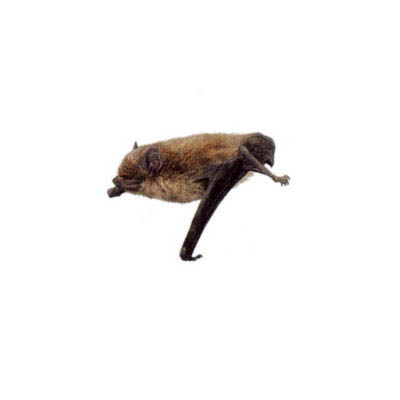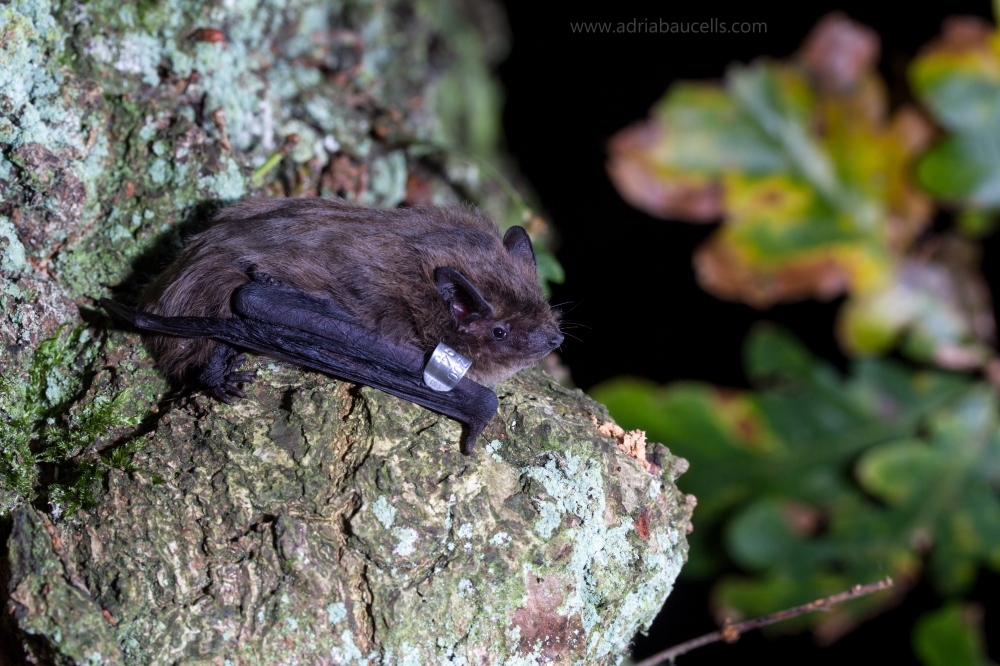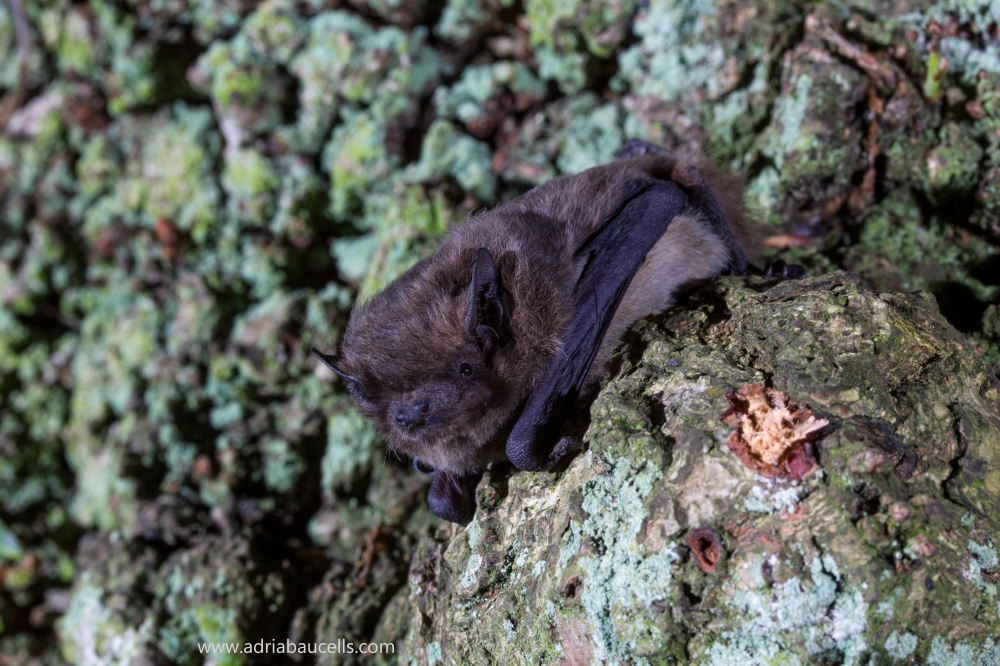Nathusius' pipistrelle bat

Pipistrellus nathusii (Keyserling et Blasius, 1839)
Vespertilionidae
Least Concern
| Other names | |
|---|---|
| Catalan | Pipistrel·la de Nathusius |
| Spanish | Murciélago de Nathusius |
| English | Nathusius' pipistrelle bat |
| French | Pipistrelle de Nathusius |
| Basque | Nathusius pipistrelo |
| Galician | Morcego de Nathusius |
Description
Small bat measuring between 44 and 50 mm in length (head and body), a forearm ranging from 32 to 37 mm, a wingspan from 230 to 250 mm, ears between 10 and 16 mm, a tail measuring between 30 and 40 mm, and weighing between 6 and 10 g. The skin is dark brown and may have a slightly lighter margin on the outer edge of the wing. The fur is relatively uniform and varies with the season, being darker or grayish-brown in winter and more reddish in summer. The ventral side is usually lighter, and the dorsal side is more brown.
The wing venation pattern is one of its main characteristics for distinguishing it from other species, such as the Kuhl's pipistrelle (Pipistrellus kuhlii), as well as dental features. Being a migratory species, its wings are relatively long compared to other pipistrelles.
Fotografies
Distribution
Its distribution covers almost all of Europe, from Mediterranean areas to Russia and Scotland, Turkey, the Caucasus, and western Asia. It reaches as far north as Scotland, Sweden, and Finland. This species can be found on Mediterranean islands such as Crete, Sardinia, and Mallorca. As a migratory species, breeding areas are in the northeast of its distribution, while hibernation areas are in the southwest. In recent decades, this species has established itself in new areas such as the Netherlands, Great Britain, Switzerland, Italy, and Spain.
Roosts and phenology
It primarily roosts in bark crevices, tree cavities, and bat boxes. There are records of maternity colonies in wooden ceilings of farmhouses, houses, and churches. Solitary individuals also take refuge in building crevices, bridges, and rock walls. Maternity colonies are mainly found in Eastern Germany, the Baltic countries, Belarus, Ukraine, Russia, and the United Kingdom, and typically consist of 20 to 200 females, depending on the shelter space, which is usually shared with common pipistrelles (Pipistrellus pipistrellus), Brandt's bat (Myotis brandtii), and the pond bat (Myotis dasycneme). These shelters are often changed frequently. Females usually give birth to twins or even three pups and typically leave the shelter by late July.
Mating occurs near the breeding shelters and during migration until November. Males choose mating shelters in exposed locations such as tree trunks, buildings, bridges, and observation towers, from where they emit characteristic social calls to attract females. Nathusius' pipistrelle is the bat that performs one of the longest migrations in the world, usually covering distances between the breeding (northeast) and hibernation (southwest) areas of 1,000 to 2,000 km. The longest distances recorded for marked individuals are 2,486 km from Russia to the French Alps and 2,224 km from Latvia to Navarra. It has been estimated that during migration, they cover distances of 29-48 km per night, with some individuals exceeding 80 km. However, it is known that there are resident male populations in the southern part of their distribution. It mainly hibernates in tree cavities but also in buildings and crevices in cliffs.
Habitat and diet
It typically selects structurally rich wooded areas, such as deciduous and mixed forests, flooded forests, and riparian forests, although it can also be found in coniferous forests and wooded parks. It is usually near aquatic areas and can be found from sea level up to 2,200 meters in altitude. During migration, it uses marshes, reed beds, and flooded areas as resting points and hunting grounds.
It feeds exclusively on flying insects found near bodies of water, such as dipterans with aquatic larvae, caddisflies, aphids, and other small insects. Its flight is fast and straight, less maneuverable than that of other pipistrelles, and typically occurs at heights of 3-20 meters. Hunting areas are usually in riparian forests near water, although they also hunt over large bodies of water.
Echolocation
Its echolocation is frequency-modulated with a quasi-constant frequency (FM-QCF) component, lasting up to 12 ms. They have a frequency of maximum intensity (FME) between 35 and 40 kHz, but when there are large concentrations of individuals or they fly near wooded areas, it can rise to 43 kHz. It is difficult to distinguish from the Kuhl's pipistrelle (Pipistrellus kuhlii), which is why it is classified in the phonic group Pipistrellus kuhlii/P. nathusii. However, both species can be distinguished based on their social calls.
Status
According to the IUCN Red List, it is considered Least Concern, with an uncertain population trend. This species is protected by various national laws in different countries, such as the Eurobats Agreement, the Bern Convention, and the European Habitats and Species Directive. It is not a very abundant species, although it has a wide distribution. However, in places like Germany, its distribution area has expanded. The main threat to the species is collision in wind farms during its migration, as well as the disturbance and deforestation of the forest and aquatic habitats it needs for breeding and feeding.

